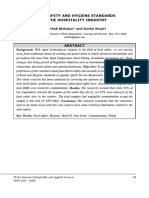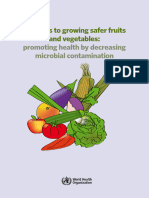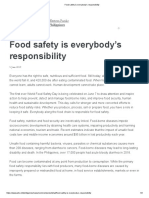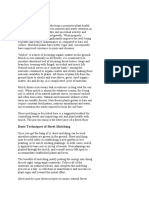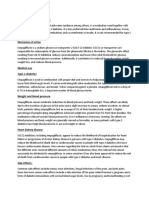Food Safety and Health
Food Safety and Health
Uploaded by
Piyush MoradiyaCopyright:
Available Formats
Food Safety and Health
Food Safety and Health
Uploaded by
Piyush MoradiyaOriginal Title
Copyright
Available Formats
Share this document
Did you find this document useful?
Is this content inappropriate?
Copyright:
Available Formats
Food Safety and Health
Food Safety and Health
Uploaded by
Piyush MoradiyaCopyright:
Available Formats
FOOD SAFETY AND HEALTH
-- By Moradiya P. B.
M.Tech PFE (Roll no. 14)
Keywords: food, food safety, health,
INTRODUCTION
Ensuring food safety and preventing food borne diseases is an international public health concern. Food safety authorities around the world are constantly challenged by changes in microorganisms and new chemicals associated with food, as well as changes in food production techniques and consumer behaviors, which lead to new risks to the public. To combat these challenges, it is critical that food safety authorities around the globe collaborate and share information and experiences. One country's problem today, could be another country's problem tomorrow and there is a need to learn from each others' successes. The International Food Safety Authorities Network (INFOSAN), is a joint programme between the Food and Agricultural Organization of the United Nations (FAO) and the World Health Organization (WHO), and has been providing a mechanism to facilitate such sharing of information since 2004. The Fifty-third World Health Assembly, in resolution requested the Director-General to put in place a global strategy for surveillance of foodborne diseases and to initiate a range of other activities on food safety and health. Since then WHO has organized a strategy planning meeting on food safety (Geneva, 20-22 February 2001). Following further consultation with Member States, WHO has drawn up a global food safety strategy, including surveillance, as outlined in this article. The WHO Global Strategy for Food Safety: Defining the challenge Traditional food safety measures have not been efficient in preventing foodborne disease over the last decades. WHOs goal of reducing the public health burden of foodborne disease can best be achieved through systematic application of risk analysis. Structures and systems must therefore be developed at national, regional and international levels to survey foodborne disease, conduct risk assessments and implement risk management strategies. What is WHO doing? WHO is partner to an international, multidisciplinary and intersectoral framework that recognizes the linkages between animal, human and ecosystem health domains, and seeks to diminish the public health risk and the global impact of infectious diseases by enhancing livestock and wildlife disease intelligence, surveillance and emergency response systems at local, national, regional and international levels.
-- By Moradiya P. B.
Food production to consumption In many countries, responsibility for food safety is divided among several agencies with overlapping authority. This situation has led to a disjointed strategy for the protection of human health from foodborne disease. Following the lead of a number of developed countries, the Department of Food Safety and Zoonoses (FOS) is working to transfer the technology for an integrated production-to-consumption approach to food safety to Member States. Such an approach relies mainly on the Hazard Analysis Critical Control Point System (HACCP), which has been advocated by WHO for nearly 20 years. Retail Food retailing involves the sale of foods in supermarkets and shops and in the informal sector, such as street-food vendors and market stalls. Food handling, preparation and storage in food service establishments require special provisions. Processing This category includes a wide range of processed foods that have been manufactured using complex and highly technical methods to ensure food safety, extend shelf-life, reduce spoilage and to facilitate trade. Principles of food safety management need to be strictly applied in order to minimize the risk of potential food safety hazards. Consumer handling Advice to consumers on the storage, handling and preparation of foods in the home is an essential element of a National Food Safety Programme. Improper handling and preparation by consumers often negate the food safety measures introduced by other sectors in the earlier stages of the food-chain. Why is food safety an essential public health issue? Serious outbreaks of foodborne disease have been documented on every continent in the past decade, illustrating both the public health and social signific ance of these diseases. Foodborne diseases most seriously affect children, pregnant women, the elderly and people already affected by other diseases. Foodborne diseases not only significantly affect peoples health and well-being, but they also have economic consequences for individuals, families, communities, businesses and countries. These diseases impose a substantial burden on health-care systems and markedly reduce economic productivity. Types of food contamination Food can be contaminated by: chemicals natural toxins foreign matter Micro organisms.
-- By Moradiya P. B.
Handling food safely
We need to: avoid preparing food when sick or feeling unwell use clean equipment, plates or containers to prevent contamination of cooked food use clean equipment, rather than hands, to pick up food wear clean clothes or a clean apron wash fruit and vegetables to be eaten raw under running water.
Keeping cold food cold Avoid keeping food in the temperature danger zone of 5C - 60C. We need to: take cold groceries home to the refrigerator quickly as possible keep chilled and frozen food cold if it will be a long time before it can be placed in a refrigerator or freezer store cold food at 5C or less keep cold food in the refrigerator as much as possible Thaw frozen food in the refrigerator or microwave Check the temperature of the refrigerator regularly. Keeping hot food hot Avoid keeping food in the temperature danger zone of 5C - 60C. We need to: keep cooked food at 60C or above until served Refrigerate or freeze food that is to be prepared well in advance and reheat until steaming hot before serving
-- By Moradiya P. B.
Five key behaviors
Everyone wants to look and feel healthy. By choosing safer food, healthier nutrition and regular physical activity, you can improve your health throughout your life. These keys are important for your health no matter how old you are or where you live in the world. Look better, feel better, reduce your visits to the doctor, maintain normal blood sugar and blood pressure, keep a healthy weight these are just a few of the benefits of adopting the key behaviors. Five Keys to safer food 1. Keep clean 2. Separate raw and cooked 3. Cook thoroughly 4. Keep food at safe temperatures 5. Use safe water and raw materials
Conclusion
International compliance with new food safety and agricultural health standards can bring costs and structural changes which, in turn, can give rise to significant redistribution of welfare across countries, along supply chains affected by standards, as well as within societies as a whole. These distributional effects can come through direct changes in product, labor, and land markets and through various secondary effects (in public health, for example, or in local environmental conditions). The available evidence on this issue in developing countries remains fragmentary, and, there are significant methodological challenges to properly attributing distributional effects to standards per se. Yet, several tentative conclusions can nevertheless be drawn from the current research and other complimentary analyses.
REFERENCES:
www.fao.org www.who.int/en http://www.who.int/entity/foodsafety/en/ http://www.who.int/entity/foodsafety/foodborne_disease/en/ http://www.who.int/entity/foodsafety/codex/en/ http://www.who.int/entity/foodsafety/fs_management/en/ www.who.int/foodsafety/consumer/en
-- By Moradiya P. B.
You might also like
- Wound Assessment ChartDocument2 pagesWound Assessment ChartAnonymous H3DpmCZX100% (6)
- Sanitation Practices of Food VendorsDocument35 pagesSanitation Practices of Food VendorsGian Arlo Hilario Castro87% (31)
- Vegetables ChartDocument38 pagesVegetables ChartPiyush Moradiya100% (1)
- Research PaperDocument14 pagesResearch PaperWatashi Wa Darl Desu100% (1)
- Food Safety and Food Toxicology and Types of FoodDocument8 pagesFood Safety and Food Toxicology and Types of FoodDeepshikha PatelNo ratings yet
- Ashish Gajera B. Pharm. Project Roll No 14Document116 pagesAshish Gajera B. Pharm. Project Roll No 14Ashish Gajera100% (5)
- AIG (Grant 1122) Merino NZ - Hydroponic Fodder ProductionDocument21 pagesAIG (Grant 1122) Merino NZ - Hydroponic Fodder ProductionSourabh Sharma100% (3)
- Unit 4 FSQCDocument28 pagesUnit 4 FSQCvaralakshmi KNo ratings yet
- Food Safety Is A Scientific Discipline Describing Handling,: IssuesDocument8 pagesFood Safety Is A Scientific Discipline Describing Handling,: IssuesAmit SinghNo ratings yet
- Food Safety in HospitalsDocument13 pagesFood Safety in HospitalsSujith Kesavan Vadakke Illath100% (1)
- Essay Article On Consumer Awareness Towards Food SafetyDocument4 pagesEssay Article On Consumer Awareness Towards Food SafetyMohd Faizal Bin AyobNo ratings yet
- 9+food Safety and Hygiene Standards in The Hospitality Industry by Sarthak Mahajan and Anshu SinghDocument16 pages9+food Safety and Hygiene Standards in The Hospitality Industry by Sarthak Mahajan and Anshu Singhmaedehmohamadian80No ratings yet
- Gastronomic Guardians : Safeguarding Food Safety at Home and BeyondFrom EverandGastronomic Guardians : Safeguarding Food Safety at Home and BeyondNo ratings yet
- Abbs Project CorrectedDocument39 pagesAbbs Project CorrectedSALIHU ISAHNo ratings yet
- WHO - Five Keys To Growing Safer Fruits and Vegetables - Promoting Health by Decreasing Microbial Contamination (2012)Document40 pagesWHO - Five Keys To Growing Safer Fruits and Vegetables - Promoting Health by Decreasing Microbial Contamination (2012)davidNo ratings yet
- THC2 Chapters12Document53 pagesTHC2 Chapters12Aliana Rez Tan100% (1)
- Oodo Juliet Obiageli - End of Semester - Term Paper - Jpts InternationalDocument11 pagesOodo Juliet Obiageli - End of Semester - Term Paper - Jpts Internationaloodojuliet386No ratings yet
- ASSIGNMENT OF FOOD SAFETY AND QUALITY CONTROL Tsi AutosavedDocument12 pagesASSIGNMENT OF FOOD SAFETY AND QUALITY CONTROL Tsi AutosavedTsegaye TamiruNo ratings yet
- Food HygieneDocument28 pagesFood Hygiene4sympj5h5tNo ratings yet
- Background of The StudyDocument3 pagesBackground of The StudyKraeNo ratings yet
- Food SafetyDocument8 pagesFood SafetyJor GarciaNo ratings yet
- The Problem and Its Setting Background of The StudyDocument70 pagesThe Problem and Its Setting Background of The StudyJoana Mae M. Wamar100% (1)
- Food Safety Is Everybody's Responsibility: PhilippinesDocument3 pagesFood Safety Is Everybody's Responsibility: PhilippinesMa. Regina GasparNo ratings yet
- FQM Safe Food Vs Healthy FoodDocument11 pagesFQM Safe Food Vs Healthy FoodVladimir SurcinskiNo ratings yet
- Food Safety: A PrimerDocument4 pagesFood Safety: A PrimerjournalNo ratings yet
- Factors Impacting Food Workers and Managers Safe Food Preparation PracticesDocument28 pagesFactors Impacting Food Workers and Managers Safe Food Preparation PracticesSteffi Grace100% (1)
- Aliu Bose Seminar WorkDocument14 pagesAliu Bose Seminar WorkeverprofelijahNo ratings yet
- Food Safety in The Philippines Problems, Issues and Opportunities For The Small Farmers and ProduDocument28 pagesFood Safety in The Philippines Problems, Issues and Opportunities For The Small Farmers and Produepra97% (30)
- Food Handler's Manual: InstructorFrom EverandFood Handler's Manual: InstructorRating: 5 out of 5 stars5/5 (1)
- Modul Topic 1Document13 pagesModul Topic 1nurul izzah bahtiarNo ratings yet
- Safe Food and Nutritious Diet For The ConsumerDocument8 pagesSafe Food and Nutritious Diet For The ConsumerAnonymous OPix6Tyk5INo ratings yet
- 21BTRCS075 Sibi RK Cse (General)Document14 pages21BTRCS075 Sibi RK Cse (General)divyashri.ravichandran1713No ratings yet
- The Who Five Keys To Safer Food A Tool For Food Safety Health PromotionDocument15 pagesThe Who Five Keys To Safer Food A Tool For Food Safety Health PromotionCarlos RuizNo ratings yet
- THC2 Midterm LessonDocument16 pagesTHC2 Midterm LessonFatima FloresNo ratings yet
- Knowledge, Attitudes and Practices of Food Hygiene Among Mobile Food Ven1ors in - 1Document17 pagesKnowledge, Attitudes and Practices of Food Hygiene Among Mobile Food Ven1ors in - 1Samson ArimatheaNo ratings yet
- Risk Management Chapter 1Document31 pagesRisk Management Chapter 1Mercado jomerNo ratings yet
- Beyond HandwashingDocument8 pagesBeyond HandwashingvgmejiaNo ratings yet
- Food Handling Serving and Hygiene PractiDocument7 pagesFood Handling Serving and Hygiene PractiFarha KamilatunNo ratings yet
- Term Paper On Food SafetyDocument6 pagesTerm Paper On Food Safetyfohudenyfeh2100% (1)
- ... Thesis About Proper Hygiene Awareness Towards Food ProductionDocument25 pages... Thesis About Proper Hygiene Awareness Towards Food ProductionAngelie UmambacNo ratings yet
- Seminar PPRDocument18 pagesSeminar PPRayushman1898No ratings yet
- Specific Hygiene Procedures and Practices AssessmentDocument4 pagesSpecific Hygiene Procedures and Practices AssessmentKatherine RomeoNo ratings yet
- Food Safety: A Public Health Priority: VerdeDocument2 pagesFood Safety: A Public Health Priority: VerdeabrilNo ratings yet
- A Food Safety Health Expert - Jeffrey B. Mier Jr. BSHM 1ADocument1 pageA Food Safety Health Expert - Jeffrey B. Mier Jr. BSHM 1AJoseph MierNo ratings yet
- Tugas PrecautionsDocument4 pagesTugas PrecautionskarinaNo ratings yet
- FSQC Unit 1Document12 pagesFSQC Unit 1nousheenirfanasNo ratings yet
- Thsafety ReviewerDocument20 pagesThsafety ReviewerRONCIEL JOHN MAROTONo ratings yet
- Last Two Minutes 1Document5 pagesLast Two Minutes 1montefalcon089No ratings yet
- Literature Review: (CITATION Woldt /L 13321)Document5 pagesLiterature Review: (CITATION Woldt /L 13321)Charneil Jean CaboralNo ratings yet
- Food Safety Knowledge and Self-Reported Practices PDFDocument29 pagesFood Safety Knowledge and Self-Reported Practices PDFAlle Eiram PadilloNo ratings yet
- New AssignmentDocument3 pagesNew AssignmentDrew JoanNo ratings yet
- Food Safety and Sanitation ManagementDocument39 pagesFood Safety and Sanitation ManagementZyna MirandaNo ratings yet
- Microbial Quality and Safety of Cooked Foods Sold in Urban Schools in Ghana: A Review of Food Handling and Health Implications Ghana A Review of Food Handling and Health ImplicationsDocument10 pagesMicrobial Quality and Safety of Cooked Foods Sold in Urban Schools in Ghana: A Review of Food Handling and Health Implications Ghana A Review of Food Handling and Health ImplicationsresearchpublichealthNo ratings yet
- Basic Food Safety and Sanitation Management-NCR (Part1)Document55 pagesBasic Food Safety and Sanitation Management-NCR (Part1)ジョンナ メイ ハイミNo ratings yet
- Thc2 Module 1 Principles of Food Safety and SanitationDocument7 pagesThc2 Module 1 Principles of Food Safety and SanitationKristine Aira HernandezNo ratings yet
- Individual AssingmentDocument8 pagesIndividual Assingmenteizat abasNo ratings yet
- htc256 NURAINMARDHIAHBTMOHDZAIDDocument13 pageshtc256 NURAINMARDHIAHBTMOHDZAIDsnnar146No ratings yet
- Technician in The Technology of The TechnologyDocument4 pagesTechnician in The Technology of The TechnologyAmarjargal GanboldNo ratings yet
- Local and Foreign RRLDocument16 pagesLocal and Foreign RRLTolop Jean RoseNo ratings yet
- AssessmentDocument3 pagesAssessmentSAIDA MASAGLANGNo ratings yet
- Food Handler's Manual: StudentFrom EverandFood Handler's Manual: StudentNo ratings yet
- Does Covid-19 Affect Food Safety and Security? A Summary Report On The Extraordinary Scientific Roundtable of Iufost-Cifst On March 21, 2020Document4 pagesDoes Covid-19 Affect Food Safety and Security? A Summary Report On The Extraordinary Scientific Roundtable of Iufost-Cifst On March 21, 2020yuhu yuhu yuhuNo ratings yet
- Eer5 14013070Document18 pagesEer5 14013070Mulubrhan OkbaiNo ratings yet
- Food PoisoningDocument2 pagesFood PoisoningikkinenganioNo ratings yet
- Quality Measurement of Fruits and VegetablesDocument19 pagesQuality Measurement of Fruits and VegetablesPiyush Moradiya100% (1)
- Measuring The Thermal Conductivity of CopperDocument4 pagesMeasuring The Thermal Conductivity of CopperPiyush MoradiyaNo ratings yet
- Garlic: Marita Cantwell Department of Vegetable Crops University of California, Davis, CADocument3 pagesGarlic: Marita Cantwell Department of Vegetable Crops University of California, Davis, CAPiyush MoradiyaNo ratings yet
- Stat Basic DefinitionsDocument4 pagesStat Basic DefinitionsPiyush MoradiyaNo ratings yet
- Maize Dehusker - Cum - Sheller Reduces Drudgery in Farm WomenDocument1 pageMaize Dehusker - Cum - Sheller Reduces Drudgery in Farm WomenPiyush MoradiyaNo ratings yet
- Health Benefits of RaisinsDocument2 pagesHealth Benefits of RaisinsPiyush MoradiyaNo ratings yet
- English Booklet - Banana Pseudo Stem Final - 27!04!2011Document32 pagesEnglish Booklet - Banana Pseudo Stem Final - 27!04!2011Piyush Moradiya100% (1)
- M.Sc. (ICT in Agriculture and Rural Development)Document4 pagesM.Sc. (ICT in Agriculture and Rural Development)Piyush MoradiyaNo ratings yet
- Why MulchDocument5 pagesWhy MulchPiyush MoradiyaNo ratings yet
- Food Plant UtilitiesDocument5 pagesFood Plant UtilitiesPiyush Moradiya75% (4)
- Third WaveDocument9 pagesThird WavePiyush MoradiyaNo ratings yet
- Junagadh Bus Guide2Document8 pagesJunagadh Bus Guide2Piyush MoradiyaNo ratings yet
- Protoflow Reviews IS Legit 2023 Updated Report!Document9 pagesProtoflow Reviews IS Legit 2023 Updated Report!protoflow usaNo ratings yet
- Yin and Yang PolaritiesDocument33 pagesYin and Yang Polaritiesdanielherciu100% (1)
- Funda Drill-007: INSTRUCTIONS: Read and Understand The Questions Properly and SelectDocument9 pagesFunda Drill-007: INSTRUCTIONS: Read and Understand The Questions Properly and SelectWawit A Dela CernaNo ratings yet
- What Is AshitabaDocument2 pagesWhat Is AshitabaChristian UrbinaNo ratings yet
- Report Oleksandra CheipeshDocument9 pagesReport Oleksandra CheipeshSashka CheypeshNo ratings yet
- Chapter 1Document6 pagesChapter 1Saciid LaafaNo ratings yet
- G2-Acute-Pancreatitis (Revised)Document45 pagesG2-Acute-Pancreatitis (Revised)patriciaNo ratings yet
- Beef Stroganoff With Pasta BeansDocument2 pagesBeef Stroganoff With Pasta Beansapi-1863646770% (1)
- Finals: (Answer) Physical EducationDocument28 pagesFinals: (Answer) Physical EducationMegan CaceresNo ratings yet
- Parham, Barbara-What's Wrong With Eating Meat - Ananda Marga Publications (1979) PDFDocument11 pagesParham, Barbara-What's Wrong With Eating Meat - Ananda Marga Publications (1979) PDFDharmaMaya ChandrahasNo ratings yet
- EmpagliflozinDocument2 pagesEmpagliflozinAusaf AhmadNo ratings yet
- School Form 8 Learner Basic Health and Nutrition ReportDocument9 pagesSchool Form 8 Learner Basic Health and Nutrition ReportJayson MangubatNo ratings yet
- Program Banda AlergareDocument3 pagesProgram Banda AlergareDaniel VerenciucNo ratings yet
- Whey Protein 101 - The Ultimate Beginner's GuideDocument9 pagesWhey Protein 101 - The Ultimate Beginner's GuideSheldon Cooper100% (1)
- Candida Emotional Causes - Hanna Kroeger Healer - Natural and Vibrational HealingDocument5 pagesCandida Emotional Causes - Hanna Kroeger Healer - Natural and Vibrational HealingAnish Shakya100% (1)
- The Truth About Low-Carb DietsDocument6 pagesThe Truth About Low-Carb DietsMy SơnNo ratings yet
- Simulated Pre BoardDocument9 pagesSimulated Pre BoardRaymark MoralesNo ratings yet
- Ab Training Lou SchulerDocument5 pagesAb Training Lou Schulerchris_blair_1No ratings yet
- Lumbar Laminectomy Diskectomy Fusion PDFDocument3 pagesLumbar Laminectomy Diskectomy Fusion PDFRully SyahrizalNo ratings yet
- JCH 12237Document13 pagesJCH 12237Paijo SusenoNo ratings yet
- 66 16smbebc3 2020062610031698Document21 pages66 16smbebc3 2020062610031698enakallu.venkateshNo ratings yet
- Ix Biology Worksheet Nutrition in Mammals 1Document7 pagesIx Biology Worksheet Nutrition in Mammals 1muneeza duevesh100% (1)
- Nabeghlavi Presentation (English)Document10 pagesNabeghlavi Presentation (English)Nabeghlavi Mineral WaterNo ratings yet
- Iodine and Iron DeficienciesDocument145 pagesIodine and Iron DeficienciesAtika SugiartoNo ratings yet
- Matatag Lesson Plan For Demo 1Document3 pagesMatatag Lesson Plan For Demo 1Cajes Mery Fe75% (4)
- Transcript and ExercisesDocument7 pagesTranscript and ExercisesLily ChangNo ratings yet
- CONSUMER STUDIES - Food & Nutrition FinalDocument122 pagesCONSUMER STUDIES - Food & Nutrition Finalcianjacob46No ratings yet











